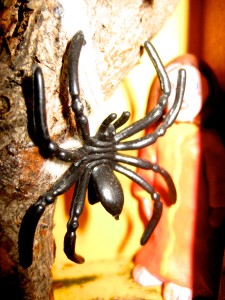
– Art by Jan Ketchel
The ego is quick to categorize the terrifying experience of a nightmare as a bad dream, best to be forgotten. The ego would be wise, however, to suspend that automatic protective judgment and ask the question: What was the function or purpose of the disturbing dream?
Behind the dream and the dreamer—our consciousness in dreams—lies the dream maker. The dream maker is the Self, the higher self that has made all the major survival decisions through the course of our life.
It is the Self in our tender years of youth who brings us fairytales to secretly live by as we encounter the harshness and brutality of actual reality that fails to safely usher us into secure psychological life. This compensatory secret life is the very one needed to nurture and tend to our fledgling ego’s fragile hold on life.
It is the Self as well that decides to fragment our overwhelming experiences in that harsh reality, burying for safekeeping our true spirit until a more opportune time to be born arises. This same Self chooses where we will be taken, what we will be shown and, most importantly, what we will emotionally experience in our nightly dreams, the intent being to better position our waking consciousness to take forward the quest for wholeness and individuation.
An encounter with a terrifying character in a dream might signal the Self’s urging to take up the task of integrating a traumatic experience, perhaps something long held in storage that left a delicate, vulnerable part of the spirit encrusted for decades. The Self might be suggesting to the ego self that the time is ripe to pick up a sword and not only face this ancient encounter, but cut through the encrustment to free this vital part of the self.
A series of frustrating, anxiety-producing mundane dreams might set the waking mood of frustration as the Self seeks to energize the waking self to break through its repetitive fixation on a habit that dominates life but imprisons the developmental needs of the self.
A sleepless night might be the Self’s decision to weaken the ego’s daytime hegemony over life so that it might raise to consciousness disturbing truths normally held in check. This may be the very thing needed to compel the ego to pay attention to its inner reality versus its usual focus on the events of the outer world and its position in it.

– Art by Jan Ketchel
There may be many varied developmental motives in the Self’s spinning of its nightly dream encounters. If the waking ego dismisses these experiences upon awakening, it not only misses the gift and deeper meaning of the Self’s intent, but it further alienates itself from the Self’s goal of individuation, likely triggering even more severe attempts by the Self to get the ego on board. This can take the form of repetitive and deepening nightmares or the breakthrough of the dream projectively into daytime life, in the form of phobias or even hallucinations.
We do well to value and appreciate the Self’s intent to lead us deeper into our wholeness, valuing all of our dreams—fairytales and nightmares alike—diligently seeking out their deeper purpose. With that fearless approach we become allies with the Self as it leads us ever deeper on our journey to wholeness.
Appreciating the dream,
Chuck
